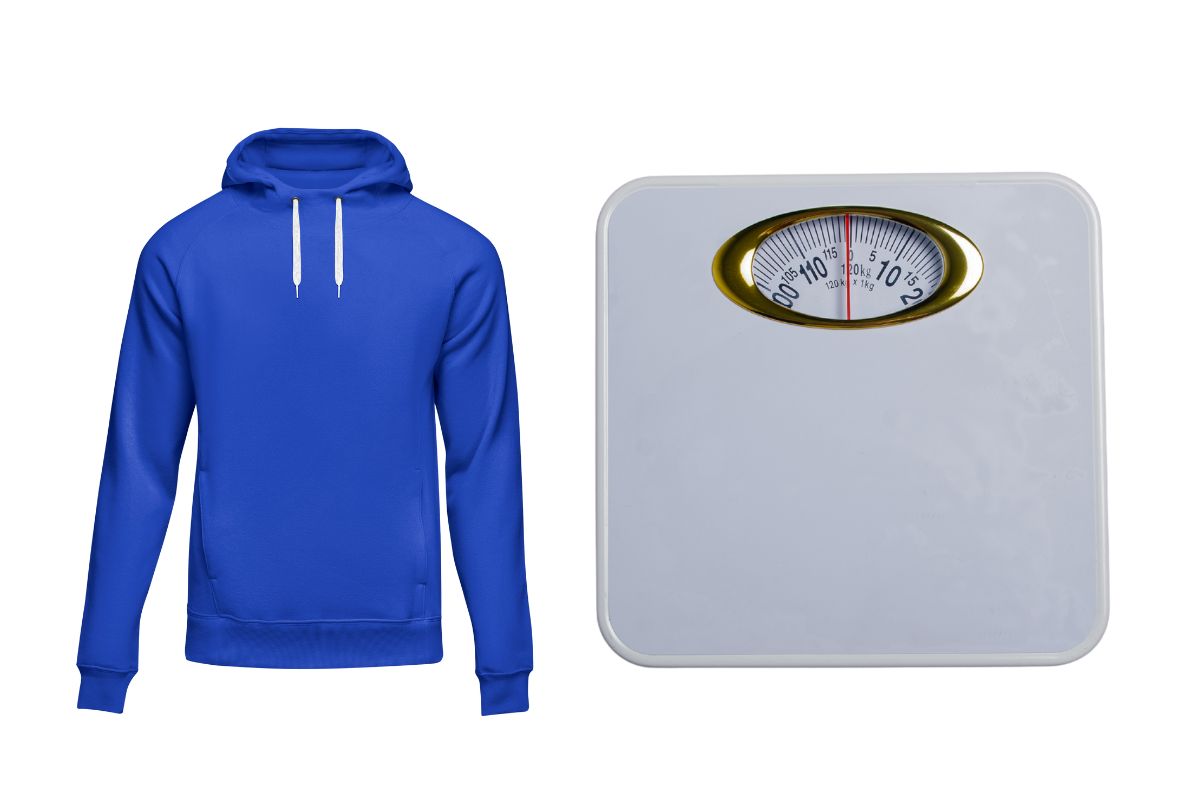When you’re shopping for a sweatshirt, weight may not be the first thing on your mind.
An average sweatshirt weighs between 0.5 to 1.7 pounds (227 to 771 grams), depending on its material, size, and design.
Knowing how much a sweatshirt weighs can help you make better choices, especially if you’re considering shipping costs or just want to be aware of how it will feel when worn.

Different styles and fabrics contribute to the weight range. A lightweight cotton sweatshirt will weigh less than a heavy fleece one.
If you’re looking for comfort, knowing the weight can help you pick the right option for your lifestyle.
Understanding Hoodie Materials

The materials used in hoodies play a big role in their weight and warmth. Knowing about different fabrics helps you choose the right hoodie for your needs. Here are some common materials used in hoodies.
Cotton Hoodies
Cotton is a popular choice for hoodies due to its softness and breathability. A cotton hoodie typically contains 100% cotton or a cotton blend. These hoodies feel comfortable against your skin and are great for casual wear.
Weight Range:
- Lightweight cotton hoodies: 8 to 12 ounces
- Mid-weight cotton hoodies: around 16 ounces
- Heavyweight cotton hoodies: 18 ounces and above
Cotton also provides good moisture absorption, keeping you dry. However, it might not be as warm as some synthetic fabrics, especially in colder weather. Look for heavyweight fabrics for added warmth.
Polyester Blends
Polyester blends combine cotton or other fibers with polyester, enhancing durability and resistance to shrinking. These hoodies are easy to care for and often dry faster than pure cotton options.
Benefits include:
- Increased stretch and flexibility
- Resistance to wrinkles
- Better shape retention
The weight of polyester hoodies usually falls between 12 to 25 ounces, depending on the blend. They can be suitable for different temperatures and activities, giving you versatility in your wardrobe.
Fleece Hoodies
Fleece hoodies are made from synthetic fibers, most commonly polyester. They are known for their warmth and soft texture. Fleece can be used in lightweight or heavyweight options, making it a great choice for colder climates.
Weight Range:
- Lightweight fleece hoodies: 10 to 14 ounces
- Heavyweight fleece hoodies: 18 ounces and up
Fleece is also excellent for insulation and retains heat well. It is breathable, ensuring you stay comfortable while moving. Look for fleece hoodies if extra warmth is a priority for you.
Types of Hoodies

Hoodies come in various styles, each designed for different purposes and comfort levels. Understanding the different types helps you choose the right one for your needs.
Pullover Hoodies
A pullover hoodie is one of the most popular styles. You put it on by pulling it over your head, which makes it simple and easy to wear.
These hoodies often have a large front pocket called a kangaroo pocket. It’s perfect for keeping your hands warm or storing small items.
Pullover hoodies are typically made from cotton or a cotton blend. They can weigh anywhere from 8 ounces for lightweight versions to around 19 ounces for regular cotton material.
They are great for casual wear or lounging. You’ll find them in many colors and designs, making it easy to express your style.
Zip-Up Hoodies
Zip-up hoodies are another common style. They feature a front zipper, allowing you to wear them open or closed. This flexibility makes them suitable for varying temperatures.
These hoodies often have similar materials as pullovers but can weigh a bit more due to the zipper. You might find light zip-up hoodies around 8 to 12 ounces, while heavyweight versions can weigh over 20 ounces.
Zip-up hoodies are practical for layering. You can wear them over a t-shirt or under a jacket, making them a versatile option for everyday wear.
Heavyweight Hoodies
Heavyweight hoodies are designed for warmth and comfort. They are typically made from thicker materials, such as dense cotton or fleece.
These hoodies usually weigh 18 ounces or more. They are ideal for cold weather as they trap more heat and provide better insulation.
In addition to warmth, heavyweight hoodies often have a durable feel. You can find them in a variety of styles, from pullover to zip-up options. Their structure makes them long-lasting, suitable for both casual and outdoor activities.
Lightweight Hoodies
Lightweight hoodies are perfect for mild weather or active use. They are made from thinner materials, making them breathable and comfortable.
These usually weigh around 8 to 12 ounces, allowing for easy packing and layering. They’re ideal for exercise, as they won’t add bulk during physical activities.
Athletic hoodies often fall into the lightweight category. Their lightweight fabric helps with moisture-wicking, keeping you dry during workouts. You can find these hoodies in various styles and colors, suitable for both workouts and casual outings.
Key Features of Hoodies

Hoodies offer several features that enhance comfort and style. Understanding these aspects can help you choose the right hoodie for your needs. Key features include pockets and zippers, lining materials, and various design elements.
Pockets and Zippers
Pockets are a popular feature in hoodies, providing convenience for storing small items. Many hoodies come with kangaroo pockets, which are large front pockets that allow easy access. They are great for keeping your hands warm or carrying essentials like your phone or wallet.
Some hoodies also include zippers, either as part of the design or functional layering. A zip-up hoodie can offer more versatility, allowing you to adjust your level of warmth easily. The combination of pockets and zippers enhances the practicality of hoodies, making them ideal for casual, daily wear.
Hoodie Lining
The lining of a hoodie significantly influences its warmth and comfort. Hoodies can have various linings, from fleece to cotton blends.
Fleece lining is soft and retains heat well, making it suitable for colder climates. In contrast, cotton blends are breathable and ideal for layering or milder temperatures. Some hoodies come with additional features like sherpa lining, known for its plush feel.
Choosing a hoodie with the right lining can ensure you stay comfortable in different weather conditions.
Design Elements
Design elements of hoodies contribute to both style and functionality. Common features include embroidery, prints, or graphics that allow for personal expression.
Many hoodies also have adjustable drawstrings in the hood. This feature lets you customize the fit and help keep warmth in. Color choices and styles can range from simple to trendy, allowing you to select a hoodie that fits your taste.
The combination of these design aspects not only enhances appearance but also your overall wearing experience.
Average Weight of Hoodies

Hoodies come in various weights, which can affect your comfort and warmth. Understanding the average weight of hoodies helps you choose the right one for your needs. Here are the main weight ranges and factors that influence hoodie weight.
Weight Range
The average weight of a hoodie varies based on its design and fabric. Generally, lightweight hoodies weigh between 8 to 12 ounces (227 to 340 grams). Mid-weight hoodies, often ideal for transitional weather, range from 10 to 16 ounces (280 to 450 grams).
Heavyweight hoodies provide the most warmth, typically weighing 18 ounces or more (around 510 grams). For example, a large hoodie usually weighs about 21 ounces, while a 2XL can be around 25 ounces. Extra-large sizes, like 5XL, might approach 30 to 31 ounces depending on their thickness and material.
Factors Affecting Hoodie Weight
Several factors can affect the weight of a hoodie. These include:
- Fabric Composition: A cotton blend or fleece will weigh more than lighter synthetic materials.
- Size: Naturally, larger sizes weigh more than smaller ones.
- Design Features: Elements like zippers, pockets, and extra thick fleece add weight.
- GSM (Grams per Square Meter): This measurement indicates fabric density. A higher GSM usually means a heavier hoodie.
By considering these factors, you can select a hoodie that meets your style and functional needs.
Practical Aspects

When considering how much a sweatshirt weighs, there are practical aspects that can influence your choices. Travel considerations and moisture-wicking properties play important roles in determining the best sweatshirt for your needs.
Travel Considerations
Weight is an important factor when you travel. A heavier sweatshirt can add more bulk to your luggage, which might be a concern during flights or road trips.
Here are some points to keep in mind:
- Weight Range: Average sweatshirts weigh between 0.5 to 1.7 pounds. Pack lighter options to save space.
- Material: Choose materials like lightweight cotton or polyester blends for easy packing and comfort.
- Layering: Consider a thin sweatshirt for layering. You can wear it under a jacket without feeling bulky.
- Versatility: Look for sweatshirts that work in different settings. A versatile design can save you from packing multiple items.
Moisture-Wicking Properties
Moisture-wicking sweatshirts are designed to pull sweat away from your body, keeping you comfortable. This can be beneficial during exercise or warmer travel conditions.
- Fabric Choices: Look for materials like polyester or moisture-wicking blends. They dry faster and help regulate temperature.
- Functionality: If you plan on outdoor activities, such as hiking, a moisture-wicking sweatshirt can keep you dry.
- Comfort Level: Staying dry improves comfort, especially on long trips. Look for sweatshirts marketed with these features.
Focusing on these aspects can help you select the right sweatshirt for your activities and travel needs.
Measurements and Weighing Methods

To measure the weight of a sweatshirt accurately, you can use various methods. The most reliable method involves using a digital scale.
This device provides precise measurements and is easy to use.
Using Digital Scales
When using digital scales, start by placing the scale on a flat surface. Make sure the scale is calibrated to zero before placing your sweatshirt on it.
This ensures you get an accurate weight without any extra measurement errors.
You can put your sweatshirt directly on the scale or use a container if it helps you keep it steady. Most digital scales will quickly display the weight in the unit you prefer, such as ounces or grams.
For best results, check the weight after adjusting for any wrinkling or extra layers.
Digital scales are reliable for measuring the weight of your sweatshirts, whether they are lightweight or heavyweight.
Sizing and Fit

Finding the right size for a sweatshirt is important for comfort and style. Proper sizing helps you choose a sweatshirt that fits well and feels good to wear. Here are key details to consider regarding hoodie sizes.
Hoodie Sizes
Hoodie sizes vary based on brand and style, so it’s essential to check specific measurements rather than rely solely on labeled sizes. Most brands provide a size chart that includes:
- Small (S): Chest width of about 19 inches.
- Medium (M): Chest width of approximately 20 inches.
- Large (L): Chest width around 21 inches.
- Extra Large (XL): Chest width of about 22 inches.
To find the best fit, take your chest measurement and compare it to the chart.
Also, consider the design; a loose fit may feel comfortable, while a tighter fit may look more polished.
Always measure your favorite sweatshirt if you’re unsure about sizes to ensure a reliable fit.
Cost Considerations

Knowing the weight of a sweatshirt is important when it comes to costs. This includes shipping costs, which can vary based on the weight and destination.
Shipping Costs
Shipping costs can change based on the weight of your sweatshirt.
Weight Ranges:
An average sweatshirt weighs between 0.5 to 1.7 pounds. Heavier sweatshirts will cost more to ship.Shipping Methods:
Different carriers may have varied rates. For example, USPS, FedEx, and UPS all have different price structures.Distance Matters:
Shipping to a nearby location is generally less expensive than to a faraway state or country.Packaging:
Choosing the right packaging can also affect costs. Ensure your sweatshirt is secured but not overly bulky.
By weighing your sweatshirt accurately, you can avoid paying too much or too little for shipping. Investing in a postage scale may save you money in the long run.
Brands and Manufacturers

When considering hoodies, different brands can greatly affect the weight and quality. Each brand has its own materials and designs, leading to variations in weight. Understanding these differences can help you make informed choices.
Hoodie Brands
There are several well-known hoodie brands that you might consider. Here are a few:
Nike: Known for innovative fabrics, Nike hoodies typically weigh between 1.5 to 3 pounds. Their athletic cuts make them popular among active individuals.
Adidas: This brand offers styles that range from lightweight to heavyweight. Most Adidas hoodies fall between 1 and 2.5 pounds.
Hanes: A more budget-friendly option, Hanes hoodies weigh about 1 to 2 pounds. They are comfortable and suitable for everyday wear.
American Apparel: Known for their fitted styles, these hoodies usually weigh around 1.5 to 2.5 pounds, using quality materials.
Champion: A classic choice, Champion hoodies are approximately 1.5 to 3 pounds, depending on the style and size.
These brands represent a mix of styles and weights, suited for various preferences and budgets.
Frequently Asked Questions

When considering the weight of sweatshirts and hoodies, it’s important to understand average weights, variations by size, and factors that may influence these numbers. Here are some common questions that can help clarify these points.
What is the average weight of a hoodie in pounds?
An average hoodie typically weighs between 0.5 to 1.7 pounds. The exact weight depends on the material and size of the hoodie.
How many grams does an average sweatshirt weigh?
The weight of an average sweatshirt ranges from 227 to 771 grams. The difference in weight is influenced by factors like fabric type and design.
What is the weight range for different sizes of sweatshirts?
Sweatshirt weights vary by size. A lightweight sweatshirt may weigh around 227 to 340 grams, while heavier options can exceed 454 grams, especially in larger sizes.
Can the weight of a hoodie affect shipping costs?
Yes, the weight of a hoodie can impact shipping costs. Heavier items typically incur higher shipping fees, which can vary by carrier and service chosen.
What does GSM mean in terms of hoodie weight?
GSM stands for grams per square meter. It measures the fabric’s density, which affects the hoodie’s warmth and thickness. A higher GSM indicates a thicker, heavier fabric.
What factors contribute to the varying weights of sweatshirts?
Several factors influence the weight of sweatshirts. Material type, size, and design features like linings or additional layers can all lead to weight differences.



